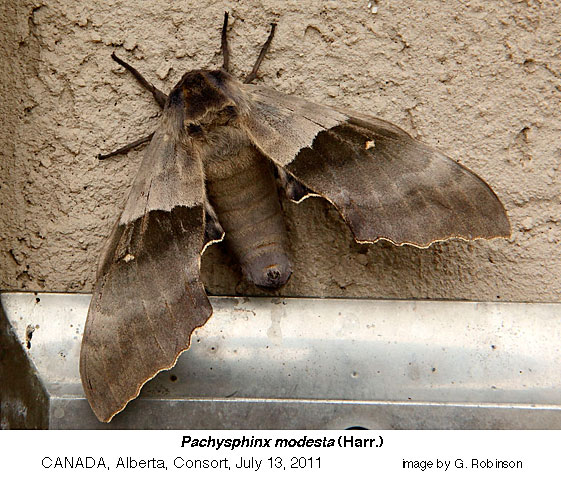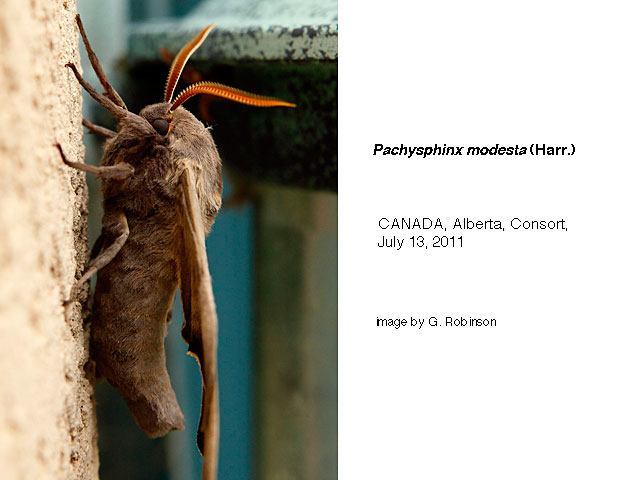Species Details
Pachysphinx modesta
University of Alberta E.H. Strickland Entomological Museum Read more about this collection »
Common NameBig Poplar Sphinx
SeasonalityAdults are on the wing from mid May through mid July.
IdentificationA very large moth (10.0-12.0 cm. wingspan) with long, narrow forewings banded with light and dark grey-brown and a maroon hindwing with a blue-black blotch in the anal angle. Nearly impossible to mistake for any other Alberta moth. Very pale specimens from southern Alberta have been called Pachysphinx occidentalis. P. occidentalis is a much lighter tan moth with more extensive maroon shading on the hindwing. However, Alberta specimens appear to grade from pale to dark forms, and all Alberta Pachysphinx are treated here as modesta, pending further study.
Scientific Name
Pachysphinx modesta
Common Name
Big Poplar Sphinx
Habitat
Open mature poplar forest or mixedwood forest with poplar.
Seasonality
Adults are on the wing from mid May through mid July.
Identification
A very large moth (10.0-12.0 cm. wingspan) with long, narrow forewings banded with light and dark grey-brown and a maroon hindwing with a blue-black blotch in the anal angle. Nearly impossible to mistake for any other…
A very large moth (10.0-12.0 cm. wingspan) with long, narrow forewings banded with light and dark grey-brown and a maroon hindwing with a blue-black blotch in the anal angle. Nearly impossible to mistake for any other Alberta moth. Very pale specimens from southern Alberta have been called Pachysphinx occidentalis. P. occidentalis is a much lighter tan moth with more extensive maroon shading on the hindwing. However, Alberta specimens appear to grade from pale to dark forms, and all Alberta Pachysphinx are treated here as modesta, pending further study.
Life History
Adult Big Poplar sphinx are nocturnal, and come readily to light. The large green larvae are reputed to be the largest insect in Alberta, based on weight. The larval stage extends from mid-July to September, and they…
Adult Big Poplar sphinx are nocturnal, and come readily to light. The large green larvae are reputed to be the largest insect in Alberta, based on weight. The larval stage extends from mid-July to September, and they overwinter in the ground as pupae.
Conservation
A common, widespread moth. No concerns.
Diet Info
No Alberta data. Elsewhere poplars, and in particular aspen poplar. There are also single reports from willow and birch, but these should be confirmed.
Range
Throughout much of North America, from the Gulf States north into the Boreal forest region across Canada. In Alberta, it occurs in cottonwood stands along the rivers of the plains (occidentalis ?) north into the…
Throughout much of North America, from the Gulf States north into the Boreal forest region across Canada. In Alberta, it occurs in cottonwood stands along the rivers of the plains (occidentalis ?) north into the boreal forest at least to Ft. McMurray, and west into the mountains at low elevations.
References
Author
Hodges, R. W.
Title
Sphingoidea : hawkmoths
Publication Date
1971
Specimen Information
There are 45 specimens of this Species.
UASM187282 - Pachysphinx modesta
University of Alberta E.H. Strickland Entomological Museum
Place CollectedCanada: Ontario, Ottawa
Date Collected1899-07-09
UASM187283 - Pachysphinx modesta
University of Alberta E.H. Strickland Entomological Museum
Place CollectedCanada: Ontario, Ottawa
Date Collected1900-06-12
CBCC1276 - Pachysphinx modesta
University of Alberta E.H. Strickland Entomological Museum
Place CollectedCanada: Alberta, Moose Lake Provincial Park
Collected ByChristensen, C. B.
Date Collected2005-02-26



